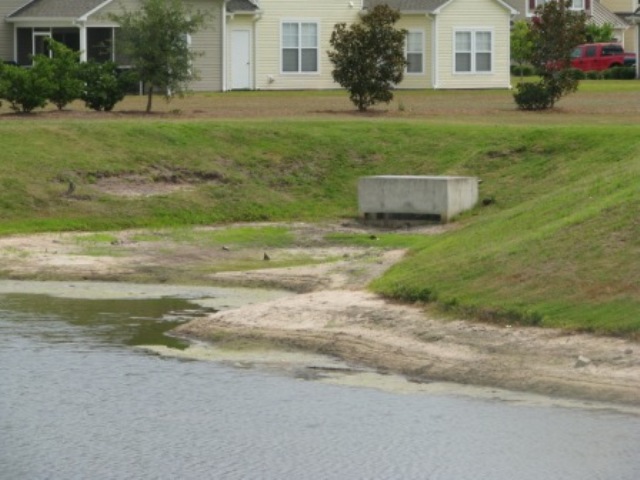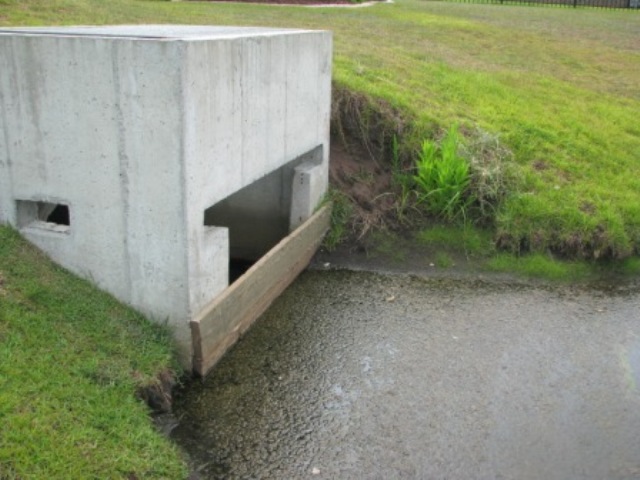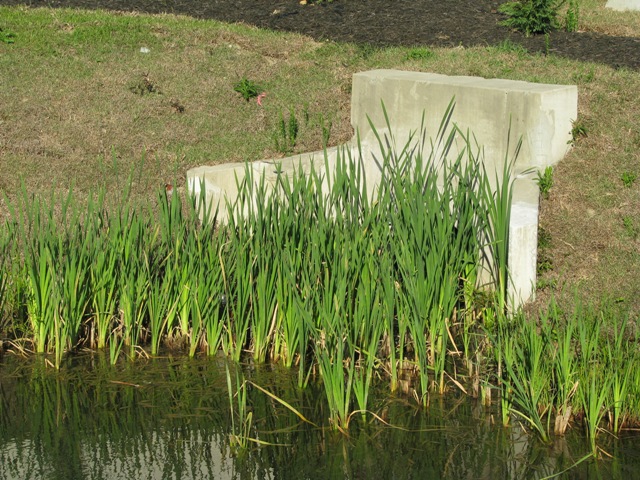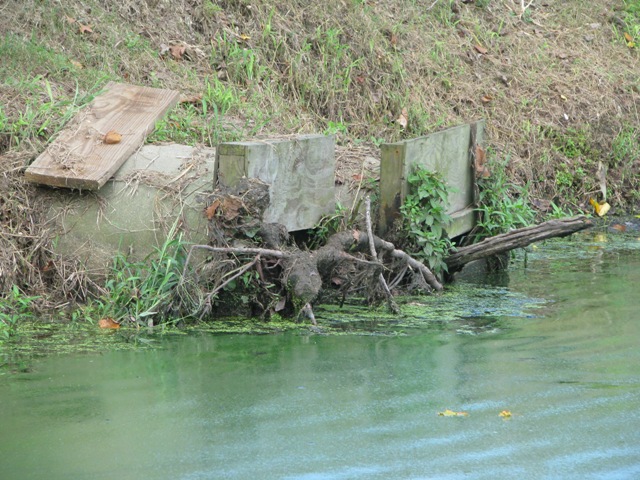Stormwater ponds manage runoff and are designed to rise and fall with each storm event (See section on Construction and Sedimentation for details). Also known as wet detention basins, stormwater ponds are designed to hold water permanently after the storm. This is referred to as the permanent pool. Within 24 hours after the storm has passed, the water surface should return to the level of the bottom of the pipe or weir or to the lowest orifice on the riser. This level is known as the normal pool. On occasion, water levels in the pond either fall below the normal pool or they remain elevated above the normal pool after the storm has passed. This page provides guidance on what to look for if your pond is not returning to the level where it should normally reside between storms.
-
The Illusion of Low Water
Sometimes older ponds appear to have low water levels, but they may not actually be low. As ponds age, minor erosion of the bank at the level of the normal pool scours the shoreline and gives an indication of where the water surface normally resides (see image above). On pond banks where lawns are mowed to the water's edge, this becomes apparent as a shelf or rim of exposed sediment. As time progresses, erosion continues and the shelf and exposed area grows and proceeds up the bank. Meanwhile, the water remains at the same level. This gives the illusion that the water level is low because the edge of the grass is well above the water surface. Waterfront owners that have watched the process over the years are aware of what has happened, but new residents in the community may be tricked by the illusion into thinking that the water level is lower than it should be. In this case, it is not the water level that has dropped, it is the bank that has retreated away from the normal pool through erosion. The only way to determine if a pond is residing at its normal pool is to check the outfall control structure at least 24 hours after any storm to see if the water is sitting at the bottom of the pipe, weir, or lowest orifice. If the water level is below the lowest orifice on the outfall, then the pond is not maintaining the normal pool as intended.
-
Low Water
Low water conditions do occur and are caused by irrigation, evaporation, exfiltration, or a broken outfall control structure.
-
Irrigation
Some communities choose to draw water from stormwater ponds for irrigation. The assumption that many communities make is that the ponds are supplied by ground water, and that that source of water is endless. In many cases the levels of stormwater ponds is independent of the ground water table, and maintenance of the permanent pool relies on the frequency of storm events. Without regular storms, irrigating from stormwater ponds will rapidly deplete the permanent pool and drop levels. It is not recommended to allow residents to irrigate with stormwater pond water because low water levels make the ponds more susceptible to weed growth, fish kills, and water quality impairments. Also, stormwater pond water may contain contaminants that residents should not broadcast over the lawn. Fecal bacteria, pesticides, and toxins may be present in the water. Last and most important, irrigating from ponds greatly limits the community's ability to manage aquatic weeds because many of the most effective aquatic herbicides carry irrigation restrictions. These aquatic herbicides can damage or kill lawns and landscape plants, so irrigating from stormwater ponds binds the hands of lake management professionals and prevents them from using some of the most effective herbicides to control undesirable aquatic weeds.

-
Evaporation and Exfiltration
During dry periods such as extended drought, evaporation and exfiltration may lower the water level below the outfall. Evaporation is loss of water to the atmosphere. Exfiltration is loss of water to the surrounding soils. Contrary to many beliefs, stormwater ponds may or may not be dug to the level of the water table. In some instances, the ponds were dug into soils that are too porous to hold water. If such soils exist on a site, then stormwater management practices other than wet ponds (pervious paving, bioretention, dry detention, etc.) should be considered.
-
Failing Outlets
Sometimes outlet control structures fail. Cracks form in the base of risers or weirs or around the connection between the riser and the pipe that leads away from the pond. This happens as concrete risers settle and shift, opening cracks and separations between the riser and the outlet pipe. In ponds that are formed by earthen dams, fissures in the dam or around the outfall pipe may allow water to drain from the pond, especially if trees are allowed to grow on the dam or beavers/muskrats burrow dens in the dam. Ponds that chronically drain below the outfall should be inspected thoroughly to determine if the outfall or dam is failing.
-
Should we install a well to maintain pond levels?
Often communities remedy low water levels by having a well dug to supplement the water. This is not recommended for several reasons:
- Ground water has different chemistry from surface water and may impair water quality in the pond and in receiving rivers and beaches.
- Pumping water out of the ground to put into surface waters is not an efficient use of water or an effective stormwater management practice. Pumping groundwater into surface ponds actually increases stormwater runoff and affects the hydrology of natural systems downstream.
- Installation of wells and maintenance of pumps is costly.
- Ground water is precious, and depletion of ground water reserves creates cones of depression and increases the likelihood of saltwater intrusion, well failure, and subsidence of the land.
If your community has halted irrigation withdrawals and ensured the outfall is not failing, yet your ponds fail to retain water, you should consult your municipal stormwater or public works department or civil engineer. There may be options for retrofits or conversions.
-
So, if a well is not the answer, what is?
The best solution is to vegetate the shoreline with native wetland plants (see section on Shoreline Plants). This helps the community solve two problems at once while providing other indirect benefits. Shoreline plants will help stop erosion, and they will obscure the water line. If the pond level tends to drop below the normal level between storms, wetland plants will colonize the riparian zone and obscure the waterline. They can survive being inundated when water levels are high, but they also can survive in moist soils when water levels drop.
-
High Water
Stormwater ponds are designed to drain and return to normal pool within 24 hours after the storm. If they are not doing so, then there must be a blockage in the outfall control structure. Blockages may result from a collapsed outfall pipe, excessive vegetation, sticks and other yard debris, the activity of a beaver, or a resident who has intentionally placed a board or weir over the outfall to raise the water level. It is extremely important that these blockages be removed and repaired immediately upon being found. They could result in significant flooding around the pond and in properties upstream. Stormwater ponds are designed to be a specific volume of empty space in order to capture the storm surge. If water levels are raised artificially, storage is lost and flooding is a real possibility.




